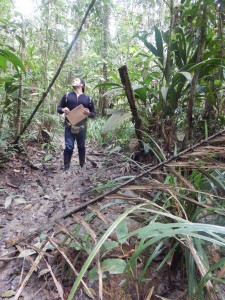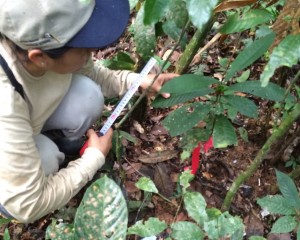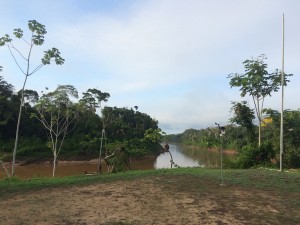For the “Applied Module at External Organizations” (AMEO) the 2nd semester Ecotox students complete an eight-week internship, either performed at an external university, governmental or industrial research institute to apply the competences achieved during their study. Several students used this opportunity to explore new places in Germany, others went out into the big, wide world. This time, Daniel Campos tells us about his internship at AIDER in Puerto Maldonado, Peru.
For my AMEO, I went into the Peruvian rain forest to support the biological monitoring, agro-forestry and research teams of AIDER. On three expeditions to the Tambopata National Reserve, I got to know regional fauna and flora, including their ecological and economic importance. Moreover, by working at AIDER I learned a lot about how a non-profit organization operates, and how important it is to continuously maintain ongoing projects year-round. The staff at AIDER was professional and respectful, allowing me to have a rewarding and adventurous experience. Alongside the social team of AIDER I even could help out at a local school educating third graders about local fauna and protected species on the occasion of International Day of Environment on June 5th.
What AIDER is researching:
The non-profit organization AIDER has the mission to harmonize sustainable development and environmental conservation through gender equity, intercultural and social inclusion, and local cooperation. Professionals working in the organization assist in the areas of biology, agro-forestry, research, sociology, anthropology, restoration ecology, chemistry, and environmental engineering.
What I actually did:
Monitoring jaguars, otters and eagles
I participated in the biological monitoring of five control/vigilance checkpoints in the reserve. At each station, we had to monitor two trails into the reserve for three consecutive days. I observed, identified and detected several species of birds and mammals which are considered important for conservation, or are indicator species. The species monitored included jaguars, wild pigs, giant otters, eagles, sparrows and parrots. Identification included not only sightings, but memorizing smell, sounds, and footprints. It was exciting but exhausting as I had to walk seven kilometers every day: four in the early morning, and three in the mid-afternoon, in the heat, carrying a heavy load, crossing muddy roads, rivers and streams.
Restoring Amazon nuts
For a restoration project of the Amazon nut Bertholletia excelsa I measured and marked growing seedlings. In addition, special features and characteristics of seedlings as well as descriptions of the surroundings were recorded. The investigated area of land was used for agro-forestry and restoration. For our research purpose, it was divided into 25 parcels which were studied individually.
Watching birds
I monitored birds in the Heath River “collpa”, which means a high elevation of land on the river bank where groups of birds stop by during their morning flights. By bird watching I learned to identify birds and other species present in the collpa. Moreover, I had to fill out recording forms concerning the behavior of the birds with regard to predators, climate and presence of tourists nearby.
(Based on an interview with Daniel Campos)



